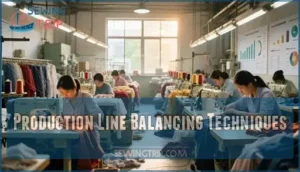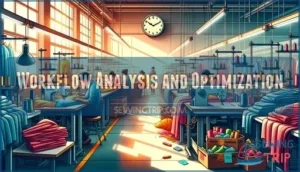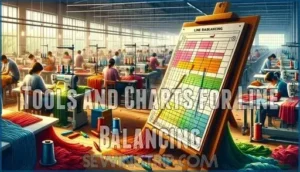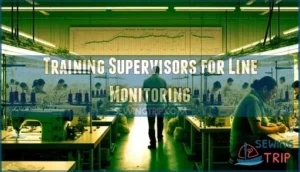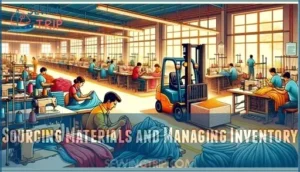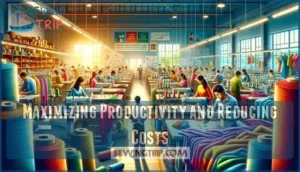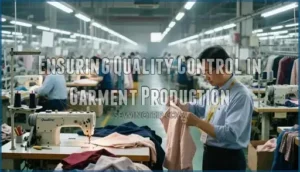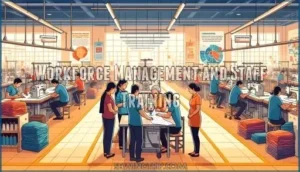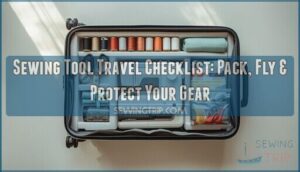This site is supported by our readers. We may earn a commission, at no cost to you, if you purchase through links.
 Running a sewing factory isn’t about standing in an office watching reports—it’s about reading the rhythm of 200 machines humming in sync, spotting the bottleneck at station 12 before it costs you an entire day’s production, and knowing exactly why your profit margin just dropped three points last quarter. The factories that thrive aren’t necessarily the ones with the newest equipment; they’re the ones where managers have mastered the delicate balance between speed and quality, cost control and worker morale.
Running a sewing factory isn’t about standing in an office watching reports—it’s about reading the rhythm of 200 machines humming in sync, spotting the bottleneck at station 12 before it costs you an entire day’s production, and knowing exactly why your profit margin just dropped three points last quarter. The factories that thrive aren’t necessarily the ones with the newest equipment; they’re the ones where managers have mastered the delicate balance between speed and quality, cost control and worker morale.
Whether you’re stepping into your first management role or looking to tighten up operations that have gotten sloppy, the difference between a factory that barely breaks even and one that consistently hits targets comes down to a handful of learnable skills. Get the fundamentals right—production flow, inventory control, workforce management, and smart use of technology—and you’ll transform chaos into profitable precision.
Table Of Contents
- Key Takeaways
- What Does It Take to Manage a Sewing Factory?
- How to Set Up an Efficient Sewing Production Line
- Sourcing Materials and Managing Inventory
- Maximizing Productivity and Reducing Costs
- Ensuring Quality Control in Garment Production
- Workforce Management and Staff Training
- Leveraging Technology for Factory Efficiency
- Financial Planning and Sustainable Growth Strategies
- Frequently Asked Questions (FAQs)
- Conclusion
Key Takeaways
- Managing a sewing factory successfully hinges on mastering production line balancing, inventory control, workforce development, and lean manufacturing principles—not just buying the newest equipment or pushing your team harder.
- Quality control built into every production step (not just end-of-line inspections) combined with structured operator training programs dramatically reduces defects while building the supervisors who’ll lead your next growth phase.
- Your profit margins live or die by controlling COGS through smart supplier partnerships, waste reduction strategies, and real-time data tracking that catches bottlenecks before they cost you thousands in lost production.
- Technology investments like production management software, automated cutting systems, and Industry 4.0 analytics transform raw operational data into actionable efficiency gains of 30-50%, but only when paired with clear processes and trained staff who understand both the machines and the business strategy.
What Does It Take to Manage a Sewing Factory?
Running a sewing factory isn’t just about knowing how to sew—it’s about juggling production targets, keeping your team motivated, and making sure every dollar spent brings you closer to profit. You’ll need a solid mix of technical know-how, people skills, and business sense to keep operations flowing smoothly.
Let’s break down the core elements that separate successful factory managers from those who struggle to keep the lights on.
Essential Skills for Factory Managers
Running a sewing factory isn’t just about knowing how to thread a machine—it’s about juggling production flow, people problems, and profit margins all at once. You’ll need sharp skills across several areas to keep things running smoothly:
- Leadership Development and Conflict Resolution to manage your workforce
- Time Management and Strategic Planning for Production Line Optimization
- Performance Metrics tracking for Manufacturing Productivity and Quality Control
Master Supply Chain Optimization and Workforce Management, and you’ll stay competitive.
Key Responsibilities and Daily Tasks
Your day starts before the machines even hum to life—you’re walking the floor, checking yesterday’s output numbers, troubleshooting that temperamental overlock station, and planning which operator needs coaching before the morning rush hits.
Beyond Factory Oversight, you’ll coordinate Staff schedules, adjust Production Scheduling when rush orders arrive, monitor Quality Control in Manufacturing checkpoints, and keep Daily Operations flowing through constant Task Management and Production Line Optimization that directly impacts Manufacturing Productivity and Workforce Management in Manufacturing throughout your Production Process.
Understanding Factory Profitability
Managing the floor is only half the battle—profitability hinges on how well you track Financial Metrics and control costs. Understanding your Profit Margins means knowing where Revenue Streams flow from and where money bleeds out through inefficiencies or Quality Control failures.
- Cost Analysis reveals whether fabric waste or machine downtime is quietly draining your budget
- Production Efficiency directly impacts your bottom line—faster throughput with fewer defects means healthier margins
- Budget Planning ties Operational Mastery to Supply Chain Management, ensuring you’re competitive without sacrificing quality
Effective management also involves implementing supply chain optimization to reduce costs and improve efficiency.
How to Set Up an Efficient Sewing Production Line
Setting up an efficient production line isn’t just about arranging machines—it’s about creating a rhythm where every station flows smoothly into the next. You’ll need to balance workloads, eliminate bottlenecks, and train your team to spot problems before they snowball.
Let’s break down the core techniques that’ll keep your line running like a well-oiled machine.
Production Line Balancing Techniques
Production Line Balancing is where the magic happens—turning chaos into rhythm. Smart resource allocation slashes bottlenecks, boosts production efficiency from 44% to 53%, and keeps your sewing lines humming without idle time eating profits.
You’ll want to choose the right method: the Largest Candidate Rule and Rank Positional Weighted both deliver 90% balance accuracy, while Moodie Young uses fewer machines (just 39 versus 52) and cuts double workstations to three.
Effective sewing line balancing is essential for maximizing productivity and efficiency in apparel manufacturing.
Workflow Analysis and Optimization
Workflow analysis isn’t guesswork—it’s about tracking every single second from fabric to finished seam, spotting where your operators are waiting, walking, or wasting motion. Process mapping reveals hidden inefficiencies:
- Efficiency metrics pinpoint where production scheduling lags
- Workflow automation eliminates manual handoffs slowing operational efficiency
- Supply chain optimization guarantees materials arrive exactly when needed
Manufacturing optimization transforms scattered efforts into production process optimization that delivers measurable production efficiency gains.
Tools and Charts for Line Balancing
Balancing charts aren’t fancy theory—they’re the blueprint that shows you exactly where seconds are bleeding out and where your line’s actually humming. Industrial engineering principles meet real-world sewing line efficiency when you map each operation’s cycle time against your takt time.
Track production output, spot bottlenecks fast, and apply lean manufacturing techniques that turn workflow analysis into measurable production flow improvements—efficiency metrics you can actually bank on.
Training Supervisors for Line Monitoring
Your supervisors won’t magically know how to read those balancing charts—consistency comes from structured training that turns monitoring skills into muscle memory.
Roll out training methods that blend classroom fundamentals with hands-on line monitoring techniques—four days on supervisor roles, operational mastery, and quality control basics, then eight weeks shadowing production flow to nail sewing line efficiency and production process adjustments in real time.
Sourcing Materials and Managing Inventory
Your materials are the backbone of your production line—get them wrong, and everything downstream suffers. Smart sourcing and inventory management keep your factory running smoothly while protecting your profit margins.
Here’s how to build a supply chain that works for you, not against you.
Choosing Reliable Suppliers
Finding the right supplier isn’t about the lowest price—it’s about building partnerships that won’t let you down when deadlines hit. Start with supplier audits and compliance checks to verify certifications like ISO 9001 or OEKO-TEX. Don’t skip risk assessment or quality control inspections; about 70% of major buyers won’t work with suppliers lacking verified documentation.
Supply chain transparency matters too—ask for full traceability from raw material sourcing through production to catch subcontracting issues early and protect your reputation.
Best Practices for Material Procurement
Once you’ve locked in your suppliers, smart procurement becomes your insurance policy against production delays, budget blowouts, and quality disasters.
Order materials in batches that match your production schedule—not too early (ties up cash) or too late (stops your line cold).
Test fabric sourcing samples before committing to bulk orders, and track raw materials through supply chain management systems that flag quality control issues instantly.
Inventory Control and Waste Reduction
Fabric sitting in a warehouse doesn’t just collect dust—it eats your profit margin alive. Smart inventory management means tracking every yard through supply chain management software that flags waste before it happens.
You’ll need stock control systems that sync with production planning, so lean manufacturing principles cut fabric waste by 5–10%—turning scrap into profit through quality control checks and fabric optimization.
Adapting to Market and Supply Chain Changes
When your supply chain hiccups—whether it’s Brexit tangling fabric imports or shipping delays stalling trims—you can’t just shrug and hope the problem fixes itself.
You’ll diversify suppliers across global trade zones, monitor market trends through supply chain management dashboards, and keep backup sourcing strategies ready—because manufacturing optimization depends on adapting production planning before inventory management becomes a crisis, not after.
Maximizing Productivity and Reducing Costs
Boosting your factory’s output while cutting costs isn’t about working harder—it’s about working smarter. You’ll need to hit realistic productivity targets, keep your machines running smoothly, eliminate bottlenecks, and adopt lean principles that cut waste without sacrificing quality.
Here’s how to make every minute and every dollar count in your operation.
Achieving Planned Productivity Rates
Hitting your productivity targets isn’t just about pushing your team harder—it’s about creating the conditions where efficiency becomes second nature. Start by tracking productivity metrics and using efficiency tools to monitor performance in real-time.
Workflow optimization hinges on smart production scheduling that aligns your team’s capacity with actual demand, while performance monitoring catches bottlenecks before they derail your entire production process optimization strategy.
Upgrading and Maintaining Machinery
Your machinery is only as productive as its last maintenance check—and outdated equipment can quietly bleed profits faster than any workflow issue you’ll ever face. Invest in machine upgrades that match your actual production needs, not just the shiniest models. Implement maintenance scheduling to prevent costly downtime, and prioritize equipment calibration to keep your sewing machines running at peak performance.
- Schedule machinery inspection weekly to catch issues before they escalate
- Align tool optimization with lean manufacturing principles to eliminate waste
- Upgrade industrial sewing machines strategically based on production volume data
- Train operators on proper equipment operation to extend machine lifespan
- Use agile production methods to test new machinery before full-scale implementation
Streamlining Production Processes
Smooth machinery won’t mean much if the steps between cutting and finishing are tangled up in wasted motion, bottlenecks, and rework loops that eat away at your daily output.
Map your production flow end-to-end to identify where garments stall, then redesign workstations so operational efficiency isn’t just a buzzword—it’s your baseline.
Track efficiency metrics like throughput time and defect rates to measure real manufacturing optimization gains.
Implementing Lean Manufacturing Principles
Lean Manufacturing turns theoretical waste reduction into measurable supply chain management wins. Factories applying lean tools like 5S and JIT cut defects from 12.7% to 6.71% while boosting operational efficiency by 3.75%.
Focus your production process on eliminating non-value activities through process optimization, and you’ll see quality control improvements alongside cost savings that protect profitability even when market conditions shift.
Ensuring Quality Control in Garment Production
Quality control isn’t just about catching defects—it’s about building a reputation you can stand behind. When your standards are clear and your team knows how to uphold them, you’ll spend less time fixing problems and more time growing your business.
Here’s how to build a quality system that actually works.
Setting and Monitoring Quality Standards
If you think quality control is just about catching defects at the end of the line, you’re already behind—because standards worth hitting get built into every step of your production process from day one.
Start with clear Standardization Methods that your team can actually follow—spec sheets with tolerance ranges, stitch counts, and acceptable color variance.
Your Quality Assurance framework links Production Planning directly to measurable benchmarks, so Defect Analysis becomes proactive instead of reactive.
Compliance Audits verify your Manufacturing Systems stay consistent, turning Quality Control and Assurance into muscle memory rather than afterthought inspections.
Inspection Processes and Audits
Routine garment factory audits aren’t optional—most facilities face 3-5 Compliance Standards reviews annually, with Audit Frequency climbing to 6-10 for complex operations.
Your Inspection Tools need precision, because manual Quality Control processes hit 60-80% accuracy while AI-driven systems push past 95%.
Defect Analysis reveals stains dominate at 39.6%, skip stitches at 20.4%, so your Quality Assurance strategy and Inventory Management must target these patterns before pre-shipment inspections catch what you should’ve fixed on the line.
Training Staff for Quality Assurance
Quality assurance doesn’t start with inspections—it starts with building a workforce that actually knows what "good" looks like before the first stitch hits fabric. Your Sewing Operators need structured Training Modules that connect Quality Control standards to Performance Metrics they’ll hit daily:
- Staff Assessment identifying skill gaps before defects multiply on the production floor
- Assurance Protocols translated into hands-on practice, not just theory in binders gathering dust
- Operational Mastery benchmarks showing Manufacturing teams exactly where quality breaks down
Train for consistency, and your Quality Assurance system practically runs itself.
Managing Customer Feedback and Improvements
Customer feedback isn’t background noise—it’s your factory’s most direct line to what’s costing you repeat orders or building your reputation in the market. Set up Feedback Loops through Customer Surveys tracking Quality Ratings on every shipment, then turn responses into Improvement Plans that directly impact Quality Control processes.
When Garment Factory Audits reveal gaps, Customer Satisfaction data shows you exactly where Quality Assurance broke down—and strong Client Retention proves you fixed it.
Workforce Management and Staff Training
Your factory’s success depends on the people running your machines, and that means getting workforce management right from day one. The best equipment in the world won’t save you if your team isn’t trained properly or if turnover keeps draining your resources.
Let’s walk through the core strategies that’ll help you build and maintain a skilled, motivated production team.
Hiring Skilled Sewing Operators
Finding operators who can keep pace with your production targets while maintaining quality standards isn’t just about filling seats—it’s about building the backbone of your entire operation. You’ll want to test hands-on sewing skills during interviews, verify experience on industrial sewing machines, and gauge how well candidates respond to pressure without sacrificing precision.
Look for these traits that separate good operators from great ones:
- Speed with control – They can hit production efficiency targets without cutting corners on stitch quality
- Machine adaptability – Comfortable switching between different sewing machines and adapting to new equipment quickly
- Problem-solving instinct – They spot issues before they become costly mistakes, saving you labor and staffing headaches
- Reliability that lasts – Low absenteeism means better staff retention and lower labor costs over time
- Hunger to grow – Operators interested in sewing workshops or training programs become tomorrow’s supervisors
Structuring Soft Skills and Technical Training
Once you’ve hired operators who can deliver the goods, your next job is making sure they don’t just survive on the floor—they thrive, grow, and eventually lead your teams. Start with skill assessment to identify training needs, then build structured learning paths that mix classroom sessions with hands-on mentorship programs.
Offer sewing workshops and textile education that strengthen technical chops, while weaving in small business management basics and manufacturing fundamentals. This career development approach transforms operators into supervisors who understand both the craft and the business side of fashion entrepreneurship.
Promoting a Positive Workplace Culture
Training alone won’t cut it—you need a factory floor where people actually want to show up, speak up when something’s wrong, and push each other to hit those productivity targets without burning out. Prioritize:
- Employee Recognition that celebrates both speed and quality
- Open Communication channels so operators flag issues before they snowball
- Team Building activities that strengthen cross-department collaboration
- Conflict Resolution protocols that maintain Fair Treatment and Safety standards
This workforce optimization approach drives both entrepreneurship goals and sustainable small business management.
Supervisory Development Programs
Your best operators won’t magically become great supervisors just because they’re fast with a needle—you’ve got to build them up with structured programs that blend classroom learning and real-world floor experience.
Roll out Leadership Training with four-day workshops followed by eight weeks of Performance Coaching on the production line, where mentorship programs pair emerging supervisors with veterans who understand team management, quality control checks, and how to tackle management challenges without killing efficiency or morale.
Leveraging Technology for Factory Efficiency
Technology isn’t just a nice-to-have anymore—it’s the difference between keeping up and getting left behind. If you want your factory running smoother and your margins looking healthier, you need to know which tools actually move the needle.
Let’s look at three areas where the right tech can transform your operations.
Garment Manufacturing Software Solutions
Modern garment production management software acts as your factory’s central nervous system, connecting every operation from design to delivery. Fashion PLM software and apparel ERP systems have driven workflow efficiency gains of up to 30%, with some manufacturers reporting 50% faster electronic order creation.
You’ll find digital pattern making, supply chain optimization, and manufacturing analytics tools increasingly accessible through cloud-based platforms—64% of the industry now relies on them.
These systems centralize inventory management, cut sampling costs through virtual prototyping, and provide real-time visibility across your production floor, turning data into actionable insights that directly impact your bottom line.
Automation and Robotics in Sewing Factories
Robots aren’t just punching in for the night shift—they’re reshaping how modern sewing factories manage everything from fabric cutting to seam finishing, and the change is happening faster than most operators realize.
Smart factories are integrating Industry 4.0 technologies to transform apparel manufacturing technology:
- Automated cutting systems slice fabric with laser precision, reducing waste by up to 15%
- Robotic sewing arms manage repetitive seams while your skilled operators tackle complex construction
- AI integration monitors quality in real-time, catching defects before they become problems
- Predictive maintenance alerts you to machinery issues before breakdowns halt production
- Garment production optimization software coordinates your entire manufacturing process improvement strategy
This isn’t about replacing your team—it’s about amplifying their capabilities and freeing them from soul-crushing repetitive work.
Using Data to Drive Continuous Improvement
Every minute your sewing line runs, it’s generating data that could either reveal your next discovery or stay buried in spreadsheets nobody reads. Performance Metrics transform raw numbers into actionable insights—tracking Productivity, Quality Control, and Operational Efficiency across your entire Supply Chain. Industry 4.0 platforms merge Data Analytics with Lean Manufacturing Principles to spotlight bottlenecks before they cost you thousands.
| Metric Category | What It Reveals |
|---|---|
| Throughput Time | Where your line slows down |
| Defect Rate | Quality issues requiring immediate attention |
| Machine Downtime | Maintenance gaps killing Operational Mastery |
| Material Waste % | Cost reduction opportunities |
| Order Fulfillment | Customer satisfaction and delivery performance |
This approach turns guesswork into precision, driving continuous improvement that compounds daily.
Financial Planning and Sustainable Growth Strategies
Running a profitable sewing factory means staying on top of your numbers and thinking ahead. You can’t just focus on today’s orders—you need a financial roadmap that keeps your business competitive and growing year after year.
Let’s break down how to set realistic profit targets, control your costs, diversify your income, and build a business model that lasts.
Setting and Achieving Profit Targets
If your profit targets feel like moving goalposts, you’re not alone—most factory managers struggle to hit their numbers consistently, but the real key isn’t working harder, it’s working with clearer benchmarks and a system that turns your production data into predictable margins.
Start by tracking your revenue streams against industry trends—aim for 4–8% net profit margins while keeping cost analysis front and center.
Build financial projections that factor in production efficiency and quality control, then use budget planning to lock in those gains quarter after quarter.
Managing COGS and Profit Margins
Most factory managers watch their profit margins shrink without realizing that COGS is the silent killer—trim just 5–10% from your cost of goods sold, and you’ll see those margins climb from barely breaking even to actually banking real profit.
COGS is the silent killer—trim just 5–10% from your cost of goods sold, and margins climb from barely breaking even to banking real profit
Focus your cost analysis on these levers:
- Expense reduction through strategic sourcing and vendor renegotiation
- Inventory management that cuts holding costs and minimizes fabric waste
- Production planning to reduce labor hours per unit
- Quality control systems that prevent costly reworks
- Supply chain management for better lead times and bulk pricing
Master margin optimization with smart pricing strategies and profit forecasting that actually reflects your floor reality.
Exploring New Revenue Streams
When your sewing factory hits its stride and you’re finally banking consistent profit, it’s tempting to ride that wave forever—but the smartest managers know that diversifying revenue is what separates thriving operations from those that crumble when one income stream dries up.
Look at sewing classes, online tutorials, fabric sales, wholesale partners, retail expansion, commission work, and even grants or funding for sustainable fashion initiatives—each stream cushions you when wholesale orders slow down.
Sustainable and Competitive Business Models
Sustainability isn’t just good ethics—it’s the foundation of competitive business strategies that keep you profitable when others fold. Circular economy models, like recycling garments into new materials, waste reduction through efficient cutting, and ethical sourcing of organic fibers, drive down costs while boosting your brand reputation.
Integrate green manufacturing with water-efficient dyeing, refine your supply chain through nearshoring, and watch production efficiency climb as sustainable fashion practices attract conscious buyers willing to pay premium prices for responsibly-made goods.
Frequently Asked Questions (FAQs)
Is sewing business profitable?
Absolutely—the numbers back it up. Traditional garment manufacturers in the U.S. see net profit margins around 4–8%, while direct-to-consumer models push that closer to 45–55% gross margins by cutting out middlemen.
How to run a garment factory?
Running a clothing factory successfully starts with streamlining your production process, managing supply chain relationships, and monitoring quality metrics closely.
Focus on controlling production costs while boosting staff morale—these fundamentals drive garment manufacturing profitability and operational mastery.
What’s the hardest thing to sew?
Delicate fabrics like silk chiffon and stretchy materials such as swimwear knits top the difficulty list in garment manufacturing.
Complex embroidery, intricate patterns, and leather sewing demand specialized sewing machines and expert operator skills to achieve consistent quality.
What are some common challenges faced when managing a sewing factory?
You might think it’s all about keeping machines running—but people problems often hit harder than technical ones. Labor shortages and supply chain disruptions throw production schedules off track, while equipment maintenance issues cause costly stoppages.
Quality control suffers when you’re rushing, inventory management gets messy, and competitive business strategies demand constant adaptation to stay profitable.
How to handle last-minute design changes efficiently?
Last-minute design changes don’t have to derail your production schedule. Keep clear version control documentation, maintain agile production capabilities with flexible workstations, and use rapid prototyping to test modifications before full runs.
Strong change management processes and lean manufacturing principles help you pivot quickly without sacrificing quality control.
What certifications improve factory credibility and compliance?
Credibility isn’t built overnight—it’s earned through the right certifications. ISO Certification, Factory Audits, and Compliance Standards validate your Quality Control systems.
Pursue ISO 9001 for Quality Assurance, WRAP or SA8000 for ethical Supply Chain Management, and consider Sustainable Manufacturing Practices certifications to meet Industry 0 expectations.
How to manage seasonal demand fluctuations effectively?
You’ll want to forecast demand using past sales data, then align your production scheduling and capacity planning to match those peaks.
Build flexibility through seasonal hiring and keep inventory management tight—stock up on core materials before rushes hit, but don’t overcommit.
What insurance coverage does a sewing factory need?
Are you prepared if a fire destroys your machines tomorrow? Your sewing factory needs Liability Insurance, Worker Compensation, Equipment Coverage, and Business Interruption protection.
Small Business owners managing Quality Control challenges should also consider Cyber Insurance, especially when seeking Funding or Grants.
How to scale operations without compromising quality?
You scale by adding capacity in measured steps—test new production lines with pilot runs, then gradually increase volume. Track efficiency metrics and quality control checkpoints religiously.
Strong supply chain partnerships and cross-trained staff keep consistency intact during growth.
Conclusion
Some factories feel like organized chaos—others hum with precision. The difference isn’t luck. Learning how to manage a sewing factory means building systems that catch problems before they cascade, training teams who understand both speed and standards, and knowing when to invest versus when to simplify.
Your factory won’t fix itself overnight, but apply these fundamentals consistently, and you’ll watch scattered operations transform into predictable profit. The work’s demanding, sure—but manageable chaos beats expensive disorder every single time.

